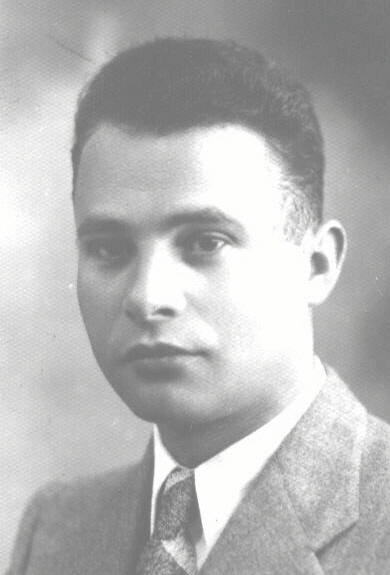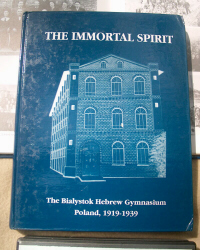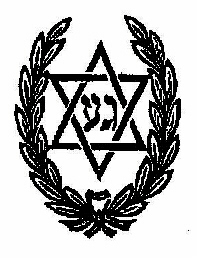Page 5
|
It has been a great privilege to realize - albeit after a delay
of more than fifty years - the dream of the principals of the Gymnasium
in its latter years: to publish a book documenting the history of this
Hebrew and Zionist institution which flourished in the Diaspora,
without government support, and under a hostile regime.
To celebrate
the twentieth anniversary of the Gymnasium, the school principals had
intended to publish a "Jubilee Book" of articles and essays contributed
by the founders, teachers, graduates and students. Several of the
Gymnasium's graduates who received this "rallying cry" from the School
Board, answered the call and sent articles to Bialystok. That was in
1939, on the eve of the Second World War and the Holocaust. The book
was never published.
|

|
The memory of the Gymnasium, which we have
cherished throughout the years, inspired us to organize a reunion of
ex-students which was held in Tel-Aviv in May 1990. We are publishing
the "70th. Anniversary Book" as a natural sequel to this reunion, and
as a fulfilment of the wish of the Gymnasium's principals to record its
special character and history in writing. The impressions of a
nostalgic meeting, however stimulating, evaporate in the course of time
and its memory fades, whilst a book containing recollections,
photographs, and descriptions of incidents from the life of each
graduation class remains an asset in every high school student's home,
and a heritage for following generations. To quote the Latin adage:
"Verba valent, scripta manent" - "Words fly away, writing
remains".
Our book makes no claim to convey a complete and comprehensive picture
of the Bialystok Hebrew Gymnasium. That would have proved a most
difficult task even for professional researchers, because the archives
of the school have been destroyed. Our intention was merely to provide
a vehicle to document the recollections and experiences of the
students, and even this modest aim was by no means easy to accomplish.
Most of the Gymnasium's students are advanced in years, and many of
them found difficulty in recalling events from the distant past. It
was not easy to sit down and put pen to paper. Many, whose memories of
their schooldays were very close to their hearts, found difficulty in
describing them because of everyday distractions, and yet in spite of
this, we received written material from a sizeable number of graduates.
On more than one occasion we were presented with contradictory versions
of certain incidents. In trying to verify these and establish their
accuracy, we resorted to libraries and interviewed people personally
and by telephone. We were helped a great deal in our research by the
students' magazines "Anachnu", "Koleinu", "Le'An", and the booklet
"Iton Ha'Yovel" published by the staff on the Gymnasium's fifth
anniversary. In this book, we have allocated ample space to these
magazines, which immortalize the spirit that then prevailed in the
Gymnasium.
Many of the Gymnasium's students went on to record
impressive achievements in the fields of science, medicine,
engineering, law, journalism, education, politics, and public service.
To mention but a few: former Prime Minister Yitzhak Shamir, Member of
Parliament Chaike Grossman, and from those who are no longer with us,
ex-Minister of Health Joseph Serlin, and the designer of the Atomic
Reactor at Dimona, Engineer Manes Prat (Prenski). Lack of space
prevents us from listing here the names of all those alumni who
presently occupy key positions in their fields.
We trust that the day
will come when an in-depth, scientific study will be undertaken,
documenting the history of the Gymnasium and the full contribution that
its graduates have made to the Jewish People, and that perhaps the
researchers will find this book of some assistance. This English
edition is a translation of the original Hebrew book entitled: "The
Hebrew Gymnasium in Bialystok (Poland)", which was published in 1992.
Many of the ex-pupils of the Gymnasium live in the Diaspora. Over the
years they have forgotten the Hebrew language, and their children and
grandchildren too are not conversant with the ancient tongue. These
graduates have expressed a wish that the book be translated into
English so that their descendants too will be able to learn of their
roots and the source from which they have drawn their inspiration, and
the spirit which beats in their hearts for the love of their birthplace
and the Hebrew language.
I have endeavoured to ensure that the book
will be published in a de luxe edition which, both in content and
character, including the many photographs, does not fall below the
standard of the original book.
In conclusion, I would like to thank my dear friend, Dr. Max Ratner
for his unwavering support, and personal encouragement. Also, I wish
to thank Electrochemical Industries (Frutarum) Ltd., the company Max
Ratner established.
Max Ratner has expressed his deeply felt wish that this book become a
guide and reference for his grandchildren. I do hope his wish will
materialize. Just before press time I heard that Dr. Max Ratner
passed away. I lost a dear friend and therefore I decided to dedicate
the book to his memory.
Yaacov Samid






